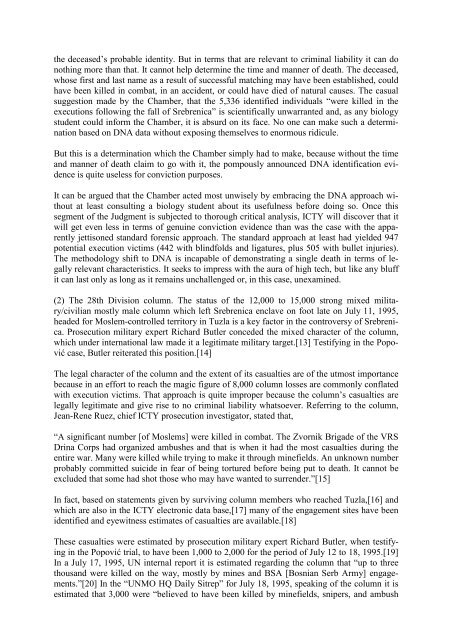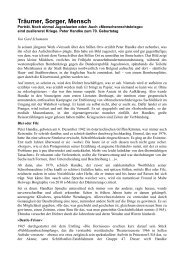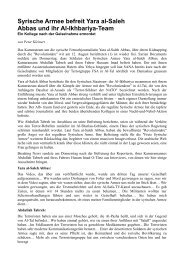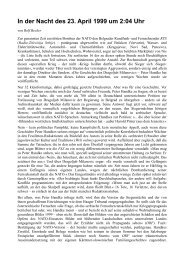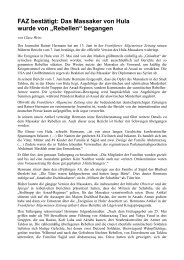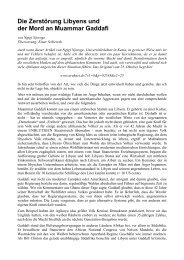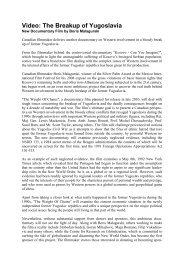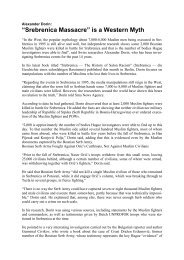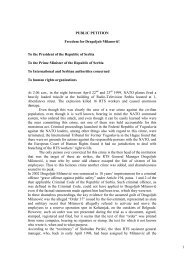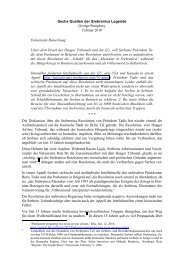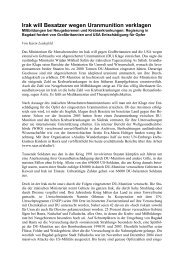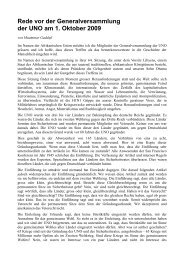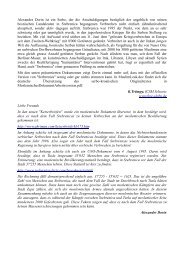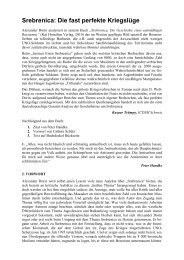What Happened at Srebrenica? Examination of the Forensic Evidence
What Happened at Srebrenica? Examination of the Forensic Evidence
What Happened at Srebrenica? Examination of the Forensic Evidence
You also want an ePaper? Increase the reach of your titles
YUMPU automatically turns print PDFs into web optimized ePapers that Google loves.
<strong>the</strong> deceased’s probable identity. But in terms th<strong>at</strong> are relevant to criminal liability it can do<br />
nothing more than th<strong>at</strong>. It cannot help determine <strong>the</strong> time and manner <strong>of</strong> de<strong>at</strong>h. The deceased,<br />
whose first and last name as a result <strong>of</strong> successful m<strong>at</strong>ching may have been established, could<br />
have been killed in comb<strong>at</strong>, in an accident, or could have died <strong>of</strong> n<strong>at</strong>ural causes. The casual<br />
suggestion made by <strong>the</strong> Chamber, th<strong>at</strong> <strong>the</strong> 5,336 identified individuals “were killed in <strong>the</strong><br />
executions following <strong>the</strong> fall <strong>of</strong> <strong>Srebrenica</strong>” is scientifically unwarranted and, as any biology<br />
student could inform <strong>the</strong> Chamber, it is absurd on its face. No one can make such a determin<strong>at</strong>ion<br />
based on DNA d<strong>at</strong>a without exposing <strong>the</strong>mselves to enormous ridicule.<br />
But this is a determin<strong>at</strong>ion which <strong>the</strong> Chamber simply had to make, because without <strong>the</strong> time<br />
and manner <strong>of</strong> de<strong>at</strong>h claim to go with it, <strong>the</strong> pompously announced DNA identific<strong>at</strong>ion evidence<br />
is quite useless for conviction purposes.<br />
It can be argued th<strong>at</strong> <strong>the</strong> Chamber acted most unwisely by embracing <strong>the</strong> DNA approach without<br />
<strong>at</strong> least consulting a biology student about its usefulness before doing so. Once this<br />
segment <strong>of</strong> <strong>the</strong> Judgment is subjected to thorough critical analysis, ICTY will discover th<strong>at</strong> it<br />
will get even less in terms <strong>of</strong> genuine conviction evidence than was <strong>the</strong> case with <strong>the</strong> apparently<br />
jettisoned standard forensic approach. The standard approach <strong>at</strong> least had yielded 947<br />
potential execution victims (442 with blindfolds and lig<strong>at</strong>ures, plus 505 with bullet injuries).<br />
The methodology shift to DNA is incapable <strong>of</strong> demonstr<strong>at</strong>ing a single de<strong>at</strong>h in terms <strong>of</strong> legally<br />
relevant characteristics. It seeks to impress with <strong>the</strong> aura <strong>of</strong> high tech, but like any bluff<br />
it can last only as long as it remains unchallenged or, in this case, unexamined.<br />
(2) The 28th Division column. The st<strong>at</strong>us <strong>of</strong> <strong>the</strong> 12,000 to 15,000 strong mixed military/civilian<br />
mostly male column which left <strong>Srebrenica</strong> enclave on foot l<strong>at</strong>e on July 11, 1995,<br />
headed for Moslem-controlled territory in Tuzla is a key factor in <strong>the</strong> controversy <strong>of</strong> <strong>Srebrenica</strong>.<br />
Prosecution military expert Richard Butler conceded <strong>the</strong> mixed character <strong>of</strong> <strong>the</strong> column,<br />
which under intern<strong>at</strong>ional law made it a legitim<strong>at</strong>e military target.[13] Testifying in <strong>the</strong> Popović<br />
case, Butler reiter<strong>at</strong>ed this position.[14]<br />
The legal character <strong>of</strong> <strong>the</strong> column and <strong>the</strong> extent <strong>of</strong> its casualties are <strong>of</strong> <strong>the</strong> utmost importance<br />
because in an effort to reach <strong>the</strong> magic figure <strong>of</strong> 8,000 column losses are commonly confl<strong>at</strong>ed<br />
with execution victims. Th<strong>at</strong> approach is quite improper because <strong>the</strong> column’s casualties are<br />
legally legitim<strong>at</strong>e and give rise to no criminal liability wh<strong>at</strong>soever. Referring to <strong>the</strong> column,<br />
Jean-Rene Ruez, chief ICTY prosecution investig<strong>at</strong>or, st<strong>at</strong>ed th<strong>at</strong>,<br />
“A significant number [<strong>of</strong> Moslems] were killed in comb<strong>at</strong>. The Zvornik Brigade <strong>of</strong> <strong>the</strong> VRS<br />
Drina Corps had organized ambushes and th<strong>at</strong> is when it had <strong>the</strong> most casualties during <strong>the</strong><br />
entire war. Many were killed while trying to make it through minefields. An unknown number<br />
probably committed suicide in fear <strong>of</strong> being tortured before being put to de<strong>at</strong>h. It cannot be<br />
excluded th<strong>at</strong> some had shot those who may have wanted to surrender.”[15]<br />
In fact, based on st<strong>at</strong>ements given by surviving column members who reached Tuzla,[16] and<br />
which are also in <strong>the</strong> ICTY electronic d<strong>at</strong>a base,[17] many <strong>of</strong> <strong>the</strong> engagement sites have been<br />
identified and eyewitness estim<strong>at</strong>es <strong>of</strong> casualties are available.[18]<br />
These casualties were estim<strong>at</strong>ed by prosecution military expert Richard Butler, when testifying<br />
in <strong>the</strong> Popović trial, to have been 1,000 to 2,000 for <strong>the</strong> period <strong>of</strong> July 12 to 18, 1995.[19]<br />
In a July 17, 1995, UN internal report it is estim<strong>at</strong>ed regarding <strong>the</strong> column th<strong>at</strong> “up to three<br />
thousand were killed on <strong>the</strong> way, mostly by mines and BSA [Bosnian Serb Army] engagements.”[20]<br />
In <strong>the</strong> “UNMO HQ Daily Sitrep” for July 18, 1995, speaking <strong>of</strong> <strong>the</strong> column it is<br />
estim<strong>at</strong>ed th<strong>at</strong> 3,000 were “believed to have been killed by minefields, snipers, and ambush


